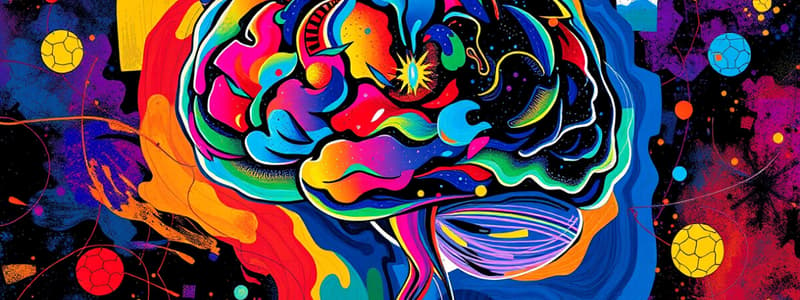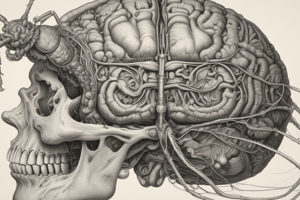Podcast
Questions and Answers
What is the primary function of glial cells in the brain?
What is the primary function of glial cells in the brain?
- Transmit electrical signals to other neurons
- Provide scaffolding and insulation for neurons (correct)
- Control the flow of blood to the brain
- Store chemical neurotransmitters
What distinguishes a neuron from other types of brain cells?
What distinguishes a neuron from other types of brain cells?
- Neurons have a soma and synapse
- Neurons lack chemical instructions from genes
- Neurons do not conduct electrical signals
- Neurons can transmit signals and have specialized extensions (correct)
Which of the following statements about the mature human brain is true?
Which of the following statements about the mature human brain is true?
- It has about 100 billion cells
- It weighs approximately 1 pound
- It contains 3 major divisions (correct)
- It primarily consists of glial cells
What role do neurotransmitters play in neuron communication?
What role do neurotransmitters play in neuron communication?
What is the approximate weight of a human brain?
What is the approximate weight of a human brain?
What is the primary function of dendrites in a neuron?
What is the primary function of dendrites in a neuron?
Which of the following best describes the presynaptic terminals of a neuron?
Which of the following best describes the presynaptic terminals of a neuron?
In which part of the nervous system are nerves located?
In which part of the nervous system are nerves located?
What maintains the stable resting membrane potential in a neuron?
What maintains the stable resting membrane potential in a neuron?
What triggers the opening of voltage-gated sodium channels in a neuron?
What triggers the opening of voltage-gated sodium channels in a neuron?
What occurs during repolarization of a neuron?
What occurs during repolarization of a neuron?
What is hyperpolarization in the context of neuron activity?
What is hyperpolarization in the context of neuron activity?
What is a characteristic feature of the refractory period in neural processing?
What is a characteristic feature of the refractory period in neural processing?
Which statement is true regarding neurotransmitters?
Which statement is true regarding neurotransmitters?
What may happen after a neuron has fired an action potential?
What may happen after a neuron has fired an action potential?
What allows for the regrowth or transplantation of severed nerves?
What allows for the regrowth or transplantation of severed nerves?
Study Notes
Overview of the Human Brain
- Genes consist of chemical chains that influence the development of the brain and body, with 20,000 to 25,000 identified.
- The mature human brain weighs approximately 1,350 grams and has a pinkish-white color, resembling firm JELL-O.
- Contains about 1 trillion cells and has three major divisions.
Key Cell Types in the Brain
- Glial Cells: Approximately 900 billion; provide structural support, insulation for neurons, and release chemicals that affect neuron growth.
- Neurons: About 100 billion; specialized cells designed for receiving and transmitting electrical signals.
Neuron Structure and Function
- Dendrites: Branched extensions from the cell body that receive signals from other cells.
- Soma (Cell Body): Egg-shaped structure that maintains neuron function and produces necessary chemicals.
- Axon: Long structure that transmits signals away from the cell body.
- Presynaptic Terminals (End Bulbs): Store neurotransmitters for communication with adjacent cells.
- Synapse: Microscopic gap (20-30 billionths of a meter) between neurons where signal transmission occurs.
Nervous System Components
- Peripheral Nervous System (PNS): Comprises nerves outside the brain and spinal cord, composed of bundled axons and dendrites; nerves can regenerate if damaged.
- Central Nervous System (CNS): Composed of neurons located in the brain and spinal cord.
Information Transmission in Neurons
- Resting Potential: Neurons maintain a stable membrane potential of about -70 mV; the inside is negatively charged due to potassium ions and negatively charged proteins.
- Threshold: If membrane potential reaches -55 mV, voltage-gated sodium channels open, initiating an action potential.
- Depolarization: Sodium ions influx leads to rapid membrane potential change, reaching +30 mV.
- Repolarization: Sodium channels close, potassium channels open to restore the negative potential.
- Hyperpolarization: Potassium efflux may overshoot, temporarily decreasing membrane potential below baseline.
- Refractory Period: A brief pause after neuron firing during which new action potentials cannot occur.
Neurotransmitters
- Approximately a dozen different chemicals vital for neuron communication that facilitate mental and physical activities.
Studying That Suits You
Use AI to generate personalized quizzes and flashcards to suit your learning preferences.
Description
This quiz explores the neurobiological foundation of psychology, focusing on the human brain's structure and development. Learn about genes, brain weight, and early developmental stages. Test your knowledge on how these elements contribute to our understanding of psychology.




